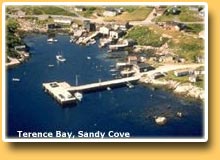
Located southwest of Halifax, the quiet fishing village of Terence Bay lies just 10 km. off the Prospect Road, Route 333. Terence Bay village consists of six distinct settlements known as "Lower Prospect", "Back Bay", Sandy Cove", "Terence Bay", "Up the River" and "Across the River" Over the centuries this peninsula has been called Terrant's Bay, Tern Bay, Turner's Bay and Turner Bay Rock. Landmarks in the village are a cairn that stands as a memorial to those who lost their lives when the "SS Atlantic" sank on April 1, 1873 off the coastline of Terence Bay and Lower Prospect, and a lighthouse on Terminal Point.
 Much of the land here was granted in 1852 to John Brophy, James A. Moren, Patrick McGloan, and the families of Drysdale, Slaunwhite and Jollimore. Settlers were Irish, Foreign Protestants, German, and French-Swiss. Prior to this, records show German families settled here as early as 1753.
Much of the land here was granted in 1852 to John Brophy, James A. Moren, Patrick McGloan, and the families of Drysdale, Slaunwhite and Jollimore. Settlers were Irish, Foreign Protestants, German, and French-Swiss. Prior to this, records show German families settled here as early as 1753.
The Slaunwhites (an anglicized form of Schlagenweit) and Jollimores outnumber the other families who first settled here including Ryans, Brophys, Bartletts, Drews, Blackburns, Littles, Hartlens, Umlahs, Countaways, Pittipas', Norris', Smiths, and Shubleys. It could be said that the blood of the Slaunwhites and Jollimores flow in the veins of nearly all the families in the village. The Harries and Martins are Slaunwhites who retained their father's Christian names as surnames, for purposes of distinction. The Jollimores are of French-Swiss origin and the Slaunwhites are Hanoverian Dutch. Both families came by way of Lunenburg from the shores of Mahone Bay.
The first Catholic Church, Saint Peter's was built around the year 1849 and a school soon followed. When Terence Bay became a separate parish, the first Pastor, Rev. Gerald Mabey, erected a beautiful grotto in honour of Our Blessed Lady. When a new and larger church was needed, a site overlooking Back Bay was chosen in 1925 and dedicated to Our Lady, Star of the Sea (Stella Maris). An Anglican church is in Sandy Cove, part of Terence Bay. The beautiful stained glass windows of St. Paul's Church of England warmly welcomes the Anglican residents of the community.
In 1938 the Sisters of Charity, who had been in residence in Upper Prospect since 1876, were asked to send teachers to Terence Bay. Travelling by boat, they arrived and built the Star of the Sea Convent in 1939. From the little white convent built on a knoll next to the church, the Sisters began house to house visitation of the village. It is recorded that poverty, sickness and discouragement were rampant and distribution of clothing and medical supplies commenced at once. The convent's kitchen served as the local clinic. While working to address nutritional and literacy needs of the community, the Sisters also taught courses in home nursing, physical education, sewing, home economics, decorating, dramatics and music.
In the 1940s there was a thriving handcraft, the Sisters of Charity provided training in weaving that led to the commercial production of the famous Nova Scotia Tartan. The original design for this fabric is still in the possession of a resident of Terence Bay. Men were offered training in woodworking, which too became a business generating local employment. Another industry in the village has been the fish plant where fish was salted and processed, and shipped to other places to sell. The first government wharf was built in 1930 and it increased fishery activities.
In 1943, Albert R. Williams came to Terence Bay during the summer and began operating "Buddy's Canteen" which served as a gathering place for local residents. Its main feature was a jukebox where youngsters danced jive and jitterbug. Mr. Williams, a Municipal Councillor for many years, was also a professional ballroom dancer. He never held a liquor license and allowed no drinking in his canteen.
Ron Slaunwhite recalls the early fire departments in the village, saying: "They got an old truck and built a tank on the back and threw a ladder on it. We used it for years." The tank was filled up at the River Bridge. Volunteers ran the department and a women's auxiliary raised funds to support it.
In the mid 1980s the Terence Bay Recreation Association held dances, bingos and youth oriented events. It operated in the Star of the Sea Church Hall.


 Much of the land here was granted in 1852 to John Brophy, James A. Moren, Patrick McGloan, and the families of Drysdale, Slaunwhite and Jollimore. Settlers were Irish,
Much of the land here was granted in 1852 to John Brophy, James A. Moren, Patrick McGloan, and the families of Drysdale, Slaunwhite and Jollimore. Settlers were Irish,